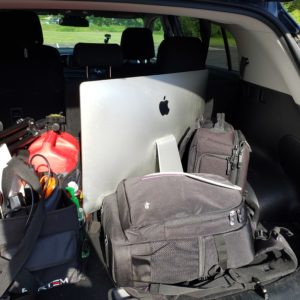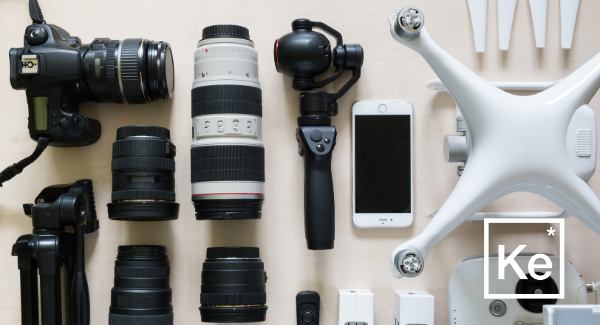We Love Camera Gizmos But…
The Ke video team gets asked quite a bit about their camera gear, especially the gimbal stabilizer. It’s always fun and exciting to talk about, however, it has the ability to distract from the video and it doesn’t really help the filming process. Or could it? Could clients knowing about the tools of the filming trade help elevate the videos we create together? Is it a waste of time to nerd out about new gear in client meetings?
Keep reading as we delve into the question “Do people need to know about your camera gear?” from two different perspectives – our fellow marketers and clients.
For Our Fellow Marketers:
Camera gear is one of the most talked about things when it comes to professional photographer forums, misled clients thinking gear matters more than skill, and YouTube tech reviews. But do your clients know anything about camera gear? Or need to?
From a practical professional standpoint, what you bring to a set is very important. Technology is great and has gotten so incredibly small. Some recording sessions don’t even require a trunk full of stuff, just a camera and a gimbal. But does that make it seem too easy?
A post from Fstoppers talking about the size of camera gear says that some people may equate big cameras and setups to quality. This then enhances the trust that the client has with you because of the effort you put into the work. However, these rigs may not necessarily change the end quality. You can put a cheap DSLR into a Ronin-M (two-handed gimbal) and achieve a worse result than a higher-end mirrorless camera on a smaller gimbal.
So the scale of the equipment has to be a factor. More equipment and setup time is necessary for larger pieces, which may affect the client in scheduling matters, something which always has to be communicated clearly and planned for. We would also argue that it needs to be deemed worthy of the effort. A Ronin-M for a few simple shots isn’t going to be worth the trouble, when a smaller gimbal or even handheld with a high frame rate would do.
Regardless of size, having professional gear is essential. Equipment that is clean and in good condition is definitely required. Don’t show up on set with a faulty tripod that you need to fix or a taped up light stand. That isn’t safe and definitely isn’t professional. The client will give you second glances and may not trust you to know what you’re doing. However, things do go wrong and even with tedious preparation, sometimes things do get a little messy. In those instances, focus on the end result and safety.

Real picture of a videographer’s car.
What it all boils down to is that it’s all about trust. If your client knows your work, knows your style and skill, then gear shouldn’t really be an issue at all. But if it’s the first time they’re working with you, then it may affect their opinion of you, for better or worse.
So, your camera gear may affect the level of trust a client has in you and it can affect the level of production, but now we come to the real question – does the client need to know all the ins and outs of the equipment? Are you just confusing them with your technical jargon and wasting valuable meeting and planning time?
For some projects, the gear is an essential part of the puzzle. When talking to the client’s project manager, they might need to know that you have a handful of GoPros you can place around the set. They may even have some great ideas of how to use them. Or you may have a gimbal and a ladder you know you can get an overhead shot with and, when you mention it, they ask about another shot with a drone that wouldn’t be possible with just your ladder and gimbal, and you may have to explain that you don’t have that capability.
When talking to a detailed project manager helping brainstorm ideas, that is when the client may need to know the basics of what gear and abilities you have at your disposal.
But are there any cases when the client needs to know that you’re shooting in 4:4:2 color bit depth? That your gimbal has 3 axis stabilization? Or your tripod is carbon fiber? RAW? F-Log? 60 or 120 fps? Premiere Pro or Final Cut?
Probably not.
Sometimes these details come up in conversation. They have a question about it because they’re curious or because they are a tech savvy person, too. If that’s not the case and unless it changes the ideas and end result of the video, then talking about these specifications is most likely boring your client or worse, wasting their time.
Instead of talking about how good your gear is, talk about how the lighting looks, and how it adds depth to the video. Or talk about how the background could be improved by removing a distraction. Those are things the client will care about and will affect the video.
For most projects, the client understands you have a camera or two, some lights, and a microphone, and that it’ll take some time to set it all up. That’s probably all the information they need to know.
For Clients:
As a client, is it important to know the specifics of the equipment your videographer uses? Yes and no.
Do make sure that your videographer’s equipment is being safely used and is in good condition. By safely used, we mean cables taped, tripods secure, and nothing is too topsy turvy. Being on-set is akin to being near a contractor, wet paint, and ladders. Sometimes, an artist’s tools can be messy and get messy, so we recommend simply asking the videographer before walking through the area they’re setting up in. And if the crew is only one person, make sure they have ample setup time.
Don’t be concerned if your videographer shows up with smaller equipment than you’ve seen used in the past. Camera gear is constantly evolving and it gets smaller every year. Gone are the days videographers went to set with cases and cases of equipment. Now, videographers often only need a backpack and a bag. While this may seem a little lackluster to some, smaller equipment doesn’t mean a dip in quality and it often cuts down on setup time.
There’s no need to spend hours educating yourself on each individual piece of equipment, though if you’re curious, don’t hesitate to ask your videographer about it prior to filming. Instead, we recommend that you ask the videographer you’ve hired the following questions. These questions will help you to better understand the process and ultimately get the most out of your videographer and your videos, no matter what type of video you want.
Question 1: What kind of lighting do you have or need?
Light is everything in video. If the lighting is bad then there is no video. If your videographer relies on natural light, then it’s important to know that so that you can direct them to a better location to film. If they do have lighting, then they may ask you to turn off the lights to not interfere with their own and you will need to be able to do that.
Question 2: What’s your focal length?
This one can get complicated with numbers, but the important thing here is to ask about the depth of field. A better way to phrase it will be, is the background behind the subject going to be blurry (like in portrait mode)? This will help tremendously in calming your fears that a messy background, including confidential documents and screens of people playing Galaga, will be completely blurred out and unobtrusive.
Question 3: How much space do you need?
While all videographers will be able to make almost any space work, it’s better to have a larger, longer space. This is so the subject can be further away from the background or back wall. Instead of planning someone to stand next to a wall, plan to have them standing further away, like in the middle of a room. This helps with the blurring of the background.
Question 4: What kind of audio are you going to capture?
Most videographers use a lavalier (lapel) mic on the subject, but some may use a boom mic on a stand. Each has their strengths, but it’s important to know for safety reasons. Plus, a videographer using a boom mic will probably require more setup time and possibly a second person.
Question 5: Are you going to move the camera?
If you require camera movement in your project, then most likely the videographer will bring an additional piece of equipment called a stabilizer. This requires more time to set up. Also, any movement will most likely have to be repeated many times to achieve the correct match of movement of camera and action of subject. So, plan for extra takes and extra time.
Question 6: What are you seeing? OR What is the composition?
By far the most common question we get is “What part of me is in frame?” Most likely there is going to be one wide camera showing from about the waist up and one close-up camera showing the chest and up. But it’s also important to ask so there’s not anything on the floor or wall, like electrical outlets, posters or general unwanted cables/items in the background.
Hopefully those questions help you out on filming day to make your video the best it can be. Aside from asking your videographer the questions above, it’s very important that the project manager the videographer has been communicating with is there on filming day. It’s key to have an insider help run the set alongside the videographer.
And remember, your videographer and you want to achieve the same result – a great video. They’re busy with a million things at once; the more you can help them, the better your video will look and sound.
In need of a high-quality video? Learn more about our video process, see examples of our work, and then get in touch for a proposal tailored to your wants and needs.



